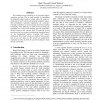Free Online Productivity Tools
i2Speak
i2Symbol
i2OCR
iTex2Img
iWeb2Print
iWeb2Shot
i2Type
iPdf2Split
iPdf2Merge
i2Bopomofo
i2Arabic
i2Style
i2Image
i2PDF
iLatex2Rtf
Sci2ools
CVPR
1999
IEEE
1999
IEEE
A Volumetric Stereo Matching Method: Application to Image-Based Modeling
We formulate stereo matching as an extremal surface extraction problem. This is made possible by embedding the disparity surface inside a volume where the surface is composed of voxels with locally maximal similarity values. This formulation naturally implements the coherence principle, and allows us to incorporate most known global constraints. Time efficiency is achieved by executing the algorithm in a coarse-to-fine fashion, and only populating the full volume at the coarsest level. To make the system more practical, we present a rectification algorithm based on the fundamental matrix, avoiding full camera calibration. We present results on standard stereo pairs, and on our own data set. The results are qualitatively evaluated in terms of both the generated disparity maps and the 3-D models.
Computer Vision | CVPR 1999 | Disparity Surface | Extremal Surface Extraction | Maximal Similarity Values |
Related Content
| Added | 02 Aug 2010 |
| Updated | 02 Aug 2010 |
| Type | Conference |
| Year | 1999 |
| Where | CVPR |
| Authors | Qian Chen, Gérard G. Medioni |
Comments (0)

